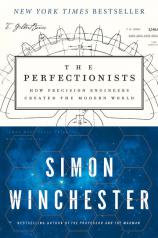The Perfectionists: How Precision Engineers Created the Modern World
Review
The Perfectionists: How Precision Engineers Created the Modern World
What could be more imprecise, haphazard and even occasionally dangerous than the life of a continent-hopping international freelance journalist? Ironically, that insanely variable contrast with experiences such as covering the Watergate scandal or being taken prisoner during the Falkland Islands War might just be a key to what is so magically compelling about Simon Winchester’s THE PERFECTIONISTS.
Journalism has been only one of the author’s several dynamic careers before he shot to public prominence in 1998 with the unexpected popularity of a book about (yawn…) the making of an iconic English dictionary. Yet THE PROFESSOR AND THE MADMAN turned out to be anything but a sleeper; this gripping historical tale launched him into a prolific nonfiction writing career that has birthed no fewer than 30 critically acclaimed titles in just two decades.
When Winchester experimentally joined an Oxford-based online ideas network (he originally trained at Oxford for his first career as a geologist), an email from a Florida scientific glassblower appeared out of the blue suggesting that he write a book about the impact of “precision” on society. That total stranger planted a seed that grew into the nearly 400 (394 to be, well, precise) pages of THE PERFECTIONISTS.
The book combines meticulous detail (embellished with irresistible footnotes), broad swaths of history, vivid personal descriptions of major engineering and design geniuses past and present, and a lively autobiographical engagement with the myriad products of their work. It takes the reader on an eclectic journey of discovery, revealing the technical miracles behind now-commonplace tools and concepts --- like reliable and repairable vehicles, timepieces, hardware (both D.I.Y. and digital), jet aircraft, the metric system, smartphones, space telescopes and a plethora of others.
"THE PERFECTIONISTS seduced me into several late nights of 'just one more chapter' and is one of the very few books I definitely plan to read again."
While the various inventions and techniques that culminated in our present era are treated more or less chronologically, Winchester begins on a more philosophical note with a fascinating discussion of the differences between accuracy and precision. To put it more simply than the author would probably want, a high average accuracy can result from practiced human skill and talent at repeatedly doing a given task. But precision is about optimal, or perfect, performance that can be infinitely repeated, at least in theory. As an avid musician, I can so relate to the many and subtle differences that entails!
Early makers of essential items such as locks, guns, clocks, mechanical instruments and the like could achieve elegant, accurate and esthetically gorgeous results for each individual item they crafted. But it wasn’t until the late 18th century that the concept of manufacturing interchangeable parts, allowing for both mass production and mass repair, slowly began to gain acceptance in Britain, America and Europe. Until then, if your one-off item broke, it could only be fixed by the individual who created it, according to the unique pattern, standards and measurements of that particular shop. Such inconvenience would be unthinkable today, except perhaps for the most specialized and expensive luxury items.
In THE PERFECTIONISTS, therefore, Winchester affirms that the Industrial Revolution did not really begin (as we were often taught in school) with iconic inventions such as the cotton gin or even the first steam engines. Instead, it all began with the first repeatable achievement of manufacturing precision, led by British engineer John “Iron Mad” Wilkinson, who devised a means of drilling an absolutely straight and true hole through a rotating round metal cylinder. It might sound simple, but it wasn’t easy. Those were the days before we had machines that could make tools, which could make parts, which could assemble those parts, and so on. Wilkinson (and several contemporaries with similar methods) made cannons safer to fire, for example, by ensuring their absolute consistency of bore diameter and wall thickness. Even more importantly, Wilkinson’s technique vastly improved the efficiency of James Watt’s steam engine, making it practical and economical as an industrial power source.
Coming full circle to our own decade, Winchester reveals how in 2010 a miniscule oil pipe in the Rolls-Royce jet engine of a nearly new Qantas Airlines Airbus A380 plane ruptured shortly after take-off and completely destroyed the engine in mid-air. In a true aviation miracle, the crew’s human accuracy and experience landed the aircraft and its 500 passengers unscathed, despite a catastrophic failure of manufacturing precision. That tiny pipe had been bored an infinitesimal amount off-center and somehow passed inspection.
Going through the design and production lives of many more landmark products and the fortunes of the companies associated with them --- Intel, Rolls-Royce, Ford, Seiko and dozens of others --- THE PERFECTIONISTS tells their corporate and individual stories with arresting clarity, grace, humor, accuracy…and, yes, even precision.
And then Winchester rounds off a thoroughly absorbing read by introducing some slightly disconcerting questions: Are we reaching the subatomic limits of precision design? Have we humans become too dependent on precision at the expense of craftsmanship and artistic unpredictability? What does the future hold for precision engineering and design? Once rhetorical, such queries are now being taken very seriously.
THE PERFECTIONISTS seduced me into several late nights of “just one more chapter” and is one of the very few books I definitely plan to read again. Like a great and profoundly inventive piece of music, it deserves repeated (if not quite precise) visits to taste the full measure of achievement.
Reviewed by Pauline Finch on June 1, 2018
The Perfectionists: How Precision Engineers Created the Modern World
- Publication Date: May 7, 2019
- Genres: History, Nonfiction
- Paperback: 416 pages
- Publisher: Harper Perennial
- ISBN-10: 0062652567
- ISBN-13: 9780062652560




